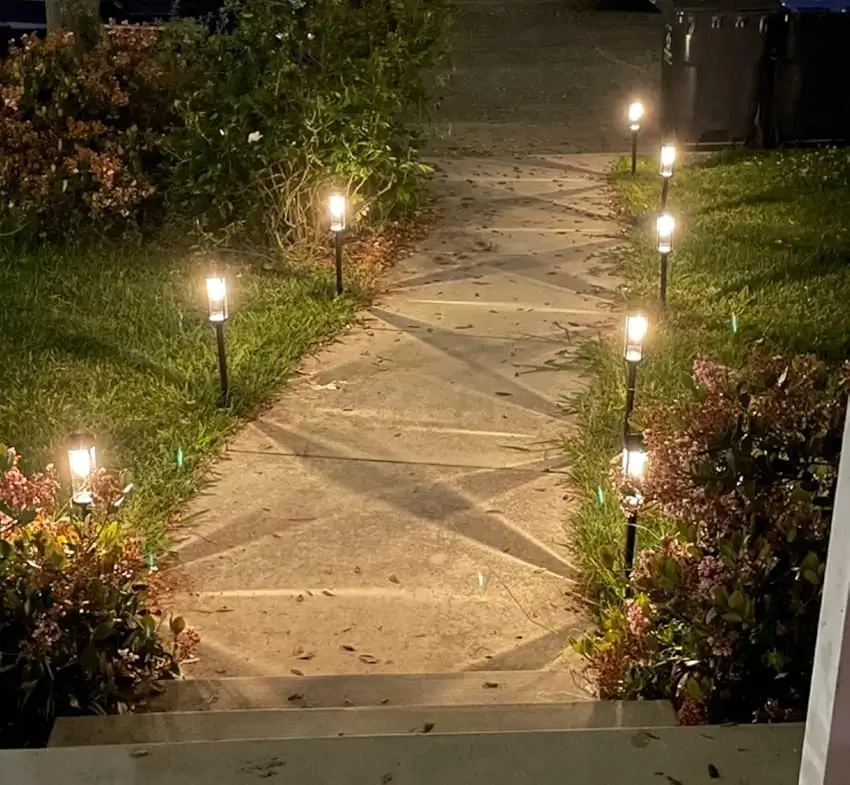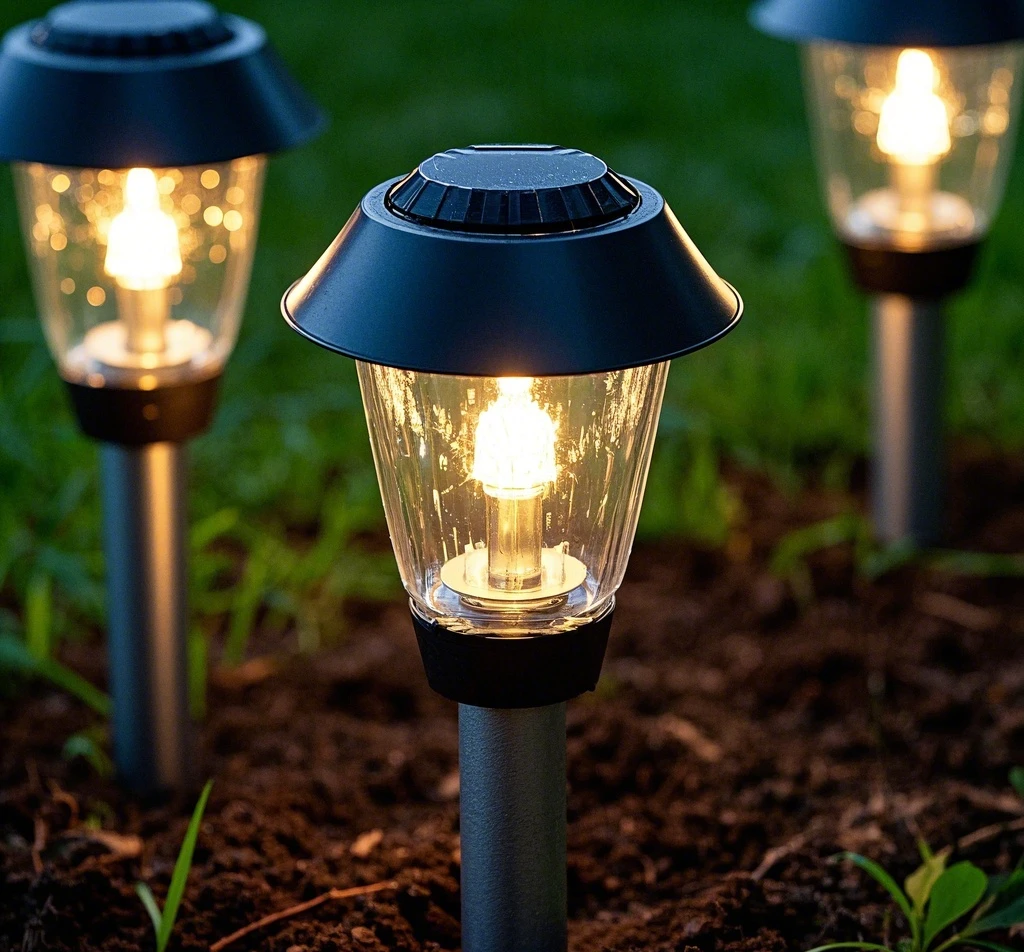When Sarah moved into her HOA-governed community in suburban Charlotte, she was thrilled to decorate her yard with outdoor lights. But her enthusiasm dimmed when she received a notice: her traditional floodlights were too bright, violating the HOA’s light pollution rules. Determined to stay compliant without sacrificing style, Sarah switched to HOA-compliant lighting—specifically, outdoor solar lights with low-glare designs. Her new solar wall lights and pathway markers cast a soft, warm glow, enhancing her yard’s charm while earning nods of approval from neighbors and the HOA board. This scenario is common across North America, where 27% of homeowners live in HOA communities, balancing personal expression with strict aesthetic and safety guidelines. Outdoor solar lights offer a practical, eco-friendly solution to illuminate yards while adhering to HOA standards, ensuring both beauty and harmony.

Why HOA-Compliant Solar Lights Are Essential
Homeowners’ Associations (HOAs) in North America enforce rules to maintain community aesthetics, safety, and neighborly harmony. Lighting is a frequent sticking point—overly bright or poorly placed lights can disrupt neighbors, violate local ordinances, or clash with the community’s look. Traditional wired lights often require permits for installation, and their high brightness can exceed HOA limits. Outdoor solar lights, like those from Linkind or Sunco, address these concerns with anti-glare designs, eco-friendly solar power, and flexible placement that doesn’t require electrical work. These lights meet common HOA requirements—such as brightness caps, color restrictions, and height limits—while offering durability and low maintenance, perfect for busy homeowners who want to stay compliant without constant oversight.
Controlling Light Pollution: Anti-Glare Designs
Light pollution is a top HOA concern, as excessive glare can disturb neighbors or create unsafe conditions. Most HOAs cap brightness at 19 lumens per square foot to prevent “light trespass” into adjacent properties. Outdoor solar lights like the Linkind SL5C Smart Solar Spotlight feature anti-glare lenses that diffuse light downward, reducing spillover. For example, Sarah used these spotlights to highlight her garden beds, directing light away from her neighbor’s windows. The lights’ luminance detection ensures dusk-to-dawn operation, activating only when needed, which further minimizes disturbance. According to Sunco Lighting’s specs, their solar pathway lights emit a soft 100–200 lumens, well within typical HOA limits, and their frosted covers prevent harsh glare, earning praise in reviews for “gentle, even light.”
Placement is key to compliance. Position solar wall lights or spotlights at least 3 feet from property lines and angle them downward to avoid shining into neighbors’ homes. For pathway lights, choose models like the Elnsivo Solar Pathway Lights, which sit low (30 cm) and focus light on walkways, ensuring safe navigation without bothering nearby residents. These strategies align with HOA guidelines, which often cite the International Dark-Sky Association’s recommendations for reducing light pollution.
Color Restrictions: Warm White and Natural White
HOA rules often mandate specific light colors to maintain a cohesive aesthetic. Bright white or colored lights can look jarring, so most communities restrict outdoor lighting to warm white (2700–3000K) or natural white (3500–4000K) tones. Outdoor solar lights like the Sunco Solar Path Light offer customizable color temperatures, letting homeowners select warm white for a cozy ambiance that blends with traditional streetlights or landscaping. For festive occasions, such as Christmas or Halloween, HOAs may allow temporary decorations, but these must also comply with color rules. Sarah opted for warm white solar string lights from Brightech, which she draped over her patio for holiday gatherings. These lights, with their soft 2700K glow, met her HOA’s seasonal decor guidelines and added charm without clashing with the neighborhood’s look.
When choosing lights, check the Kelvin rating on the packaging or product listing. For example, the Linkind SL5C offers 16 million color options but includes preset warm white and natural white modes for HOA compliance. Reviews on Amazon note their “elegant, non-intrusive glow,” making them a favorite for HOA communities. Avoid RGB (multicolor) settings for daily use, as these often violate rules unless explicitly permitted for holidays.
Installation Height: Meeting HOA Standards
HOA guidelines typically specify maximum heights for outdoor lighting to ensure safety and aesthetic harmony. For solar wall lights, heights are often capped at 1.8 meters (6 feet) to prevent overpowering neighboring properties. Ground-based outdoor solar lights, such as pathway or garden stakes, are usually limited to 2.5 meters (8 feet), though most HOA-compliant models, like the Elnsivo Solar Pathway Lights, stand at 30–60 cm to focus light downward. Sarah mounted her solar wall lights at 1.5 meters on her garage, illuminating her driveway without casting light upward. Her pathway lights, staked at 40 cm, lined her walkway, guiding guests safely while staying well below the height limit.
When installing, use adjustable mounts or stakes to fine-tune angles and heights. For example, the Linkind SL5C’s 180-degree adjustable solar panel and 90-degree light head allow precise positioning to meet HOA rules. Ensure lights are securely fastened—HOAs may flag loose or leaning fixtures as safety hazards. Solar lights’ wire-free design simplifies installation, as no trenching or electrical permits are needed, saving time and ensuring compliance.
Festive and Functional: String and Pathway Lights
For holiday cheer, warm white solar string lights are a popular choice in HOA communities. Models like the Brightech Ambience Pro Solar String Lights offer 12–15 feet of coverage, perfect for patios or pergolas, and their dusk-to-dawn sensors ensure they turn off at dawn to avoid daytime clutter. HOAs often require seasonal lights to be removed within 30 days post-holiday, so solar models are ideal for their easy setup and removal. Sarah’s string lights transformed her backyard for a Fourth of July barbecue, earning compliments for their “tasteful glow” that didn’t overwhelm the neighborhood.
Solar pathway lights are equally practical, illuminating walkways to prevent trips and falls—a key HOA safety concern. The Sunco Solar Path Light, with its IP65 waterproof rating, withstands rain and snow, ensuring year-round reliability. Place these lights along sidewalks or driveways, spacing them 6–8 feet apart for even coverage, as recommended by landscaping experts. This setup not only enhances safety but also boosts curb appeal, aligning with HOA goals for well-maintained properties.

Eco-Friendly and Low-Maintenance Benefits
Outdoor solar lights are a natural fit for HOA communities, where sustainability is increasingly valued. Powered by solar panels, these lights charge during the day (6–8 hours of sunlight) and provide 8–12 hours of illumination, reducing energy costs and environmental impact. Their built-in batteries, like the 5C automotive-grade cells in the Linkind SL5C, ensure performance even during cloudy weather, a must for regions like the Pacific Northwest. Maintenance is minimal—clean solar panels monthly with a damp cloth to ensure efficient charging, as advised by Sunco’s care guide. This low upkeep appeals to HOA boards, who often prioritize hassle-free solutions.
The absence of wiring also eliminates the need for electrical permits, a common HOA requirement for wired installations. This makes solar wall lights and pathway lights easy to install or relocate, allowing homeowners to adapt to changing HOA rules or landscaping needs. For example, Sarah repositioned her pathway lights after adding a garden bed, ensuring compliance without extra costs.
Addressing HOA Pain Points
Avoiding Violations
HOA violations for lighting are common, with 60% of HOA disputes involving aesthetics or safety, according to community management surveys. HOA-compliant lighting like outdoor solar lights prevents fines by adhering to brightness, color, and height restrictions. Their anti-glare designs reduce complaints about light trespass, and their dusk-to-dawn automation ensures lights don’t run unnecessarily, addressing concerns about energy waste.
Enhancing Community Harmony
Bright or misdirected lights can strain neighbor relations, especially in close-knit HOA communities. By choosing warm white solar wall lights and low-profile pathway lights, homeowners signal respect for shared spaces. Sarah’s neighbors appreciated her lights’ soft glow, which illuminated her yard without disturbing their evening routines. This harmony aligns with HOA goals of fostering community cohesion.
Simplifying Compliance
Navigating HOA rules can feel daunting, but outdoor solar lights simplify the process. Their adjustable designs and clear specs (e.g., lumens, Kelvin ratings) make it easy to meet guidelines. Many brands, like Linkind, provide online guides or customer support to help homeowners select compliant models, reducing the risk of errors during installation.
HOA Compliance Checklist and Communication Tips
To ensure your outdoor solar lights meet HOA standards, use this self-checklist:
- Brightness: Verify lights emit less than 19 lumens per square foot. Check product specs (e.g., Sunco Solar Path Light: 100–200 lumens) and use anti-glare lenses.
- Color: Select warm white (2700–3000K) or natural white (3500–4000K) tones. Avoid RGB or cool white unless permitted for holidays.
- Height: Keep solar wall lights under 1.8 meters and ground lights under 2.5 meters (most pathway lights are 30–60 cm).
- Placement: Direct light downward, away from neighbors’ windows, and maintain a 3-foot buffer from property lines.
- Seasonal Decor: Use warm white solar string lights for holidays and remove within HOA-specified timelines (e.g., 30 days post-event).
- Maintenance: Clean solar panels monthly and ensure lights are securely mounted to avoid safety violations.
HOA Communication Script: When submitting a lighting plan for approval, use this concise, polite approach:
Dear [HOA Board/Manager],
I’m planning to install HOA-compliant outdoor solar lights (e.g., Linkind SL5C, 200 lumens, warm white 2700K) to enhance my yard’s safety and aesthetics. The lights are anti-glare, under 1.8 meters for wall mounts, and dusk-to-dawn for efficiency. Please let me know if you need specs or a site plan. I appreciate your guidance to ensure compliance.
Best, [Your Name]
Submit this via email or your HOA’s portal, attaching product details if required. Most HOAs respond within 7–14 days, so plan installations accordingly.
Recommended Products
- Linkind SL5C Smart Solar Spotlight (2-Pack): Anti-glare, warm white (2700K), 200 lumens, IP67 waterproof, dusk-to-dawn. Adjustable for HOA height rules. Available on Amazon.
- Sunco Solar Path Light (6-Pack): 100–200 lumens, warm white (3000K), 30 cm height, anti-glare frosted lens. Ideal for walkways. Available at Sunco.com.
- Brightech Ambience Pro Solar String Lights: Warm white (2700K), 12–15 feet, dusk-to-dawn. Perfect for holiday decor. Available on Amazon.
- Elnsivo Solar Pathway Lights (4-Pack): 30 cm, warm white (3000K), IP65 waterproof, anti-glare. Suited for HOA-compliant walkways. Available on Amazon.
Conclusion: Illuminate with Confidence
HOA-compliant lighting like outdoor solar lights lets North American homeowners light up their yards without risking violations or neighbor disputes. With anti-glare designs, warm white tones, and adjustable heights, these lights meet strict HOA standards while enhancing curb appeal and safety. Whether you’re illuminating a walkway with solar pathway lights or adding festive charm with warm white string lights, solar solutions offer flexibility, sustainability, and ease of installation. By following the compliance checklist and communicating proactively with your HOA, you can create a yard that’s both beautiful and harmonious. Like Sarah, you’ll find that solar wall lights and pathway markers not only brighten your home but also strengthen your community’s shared aesthetic.


Leave a Reply